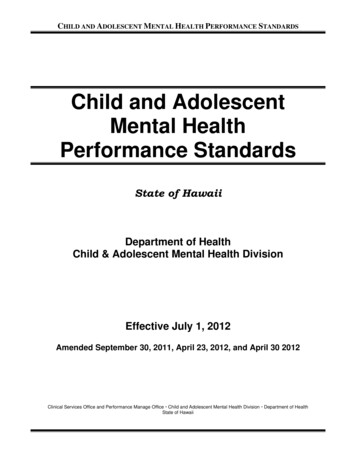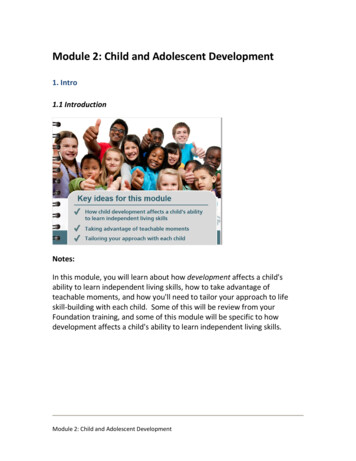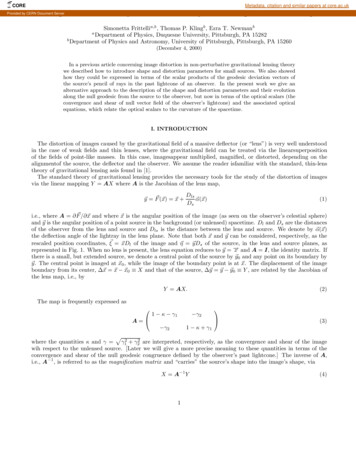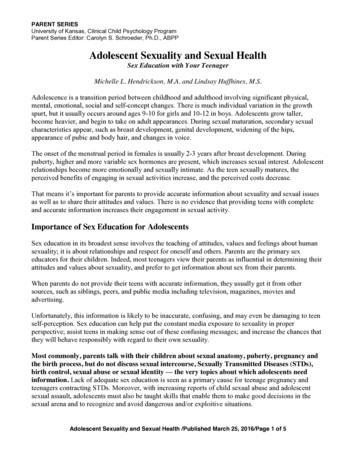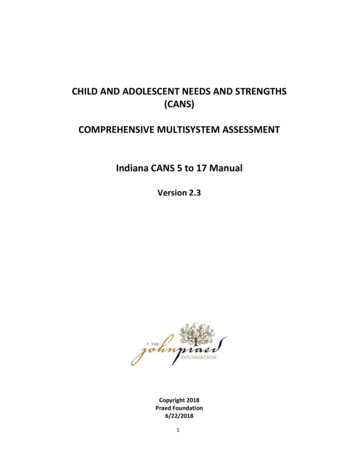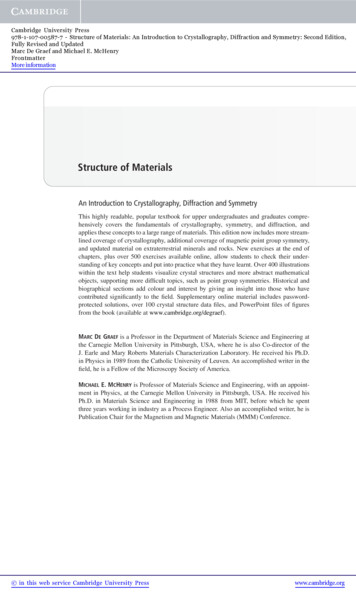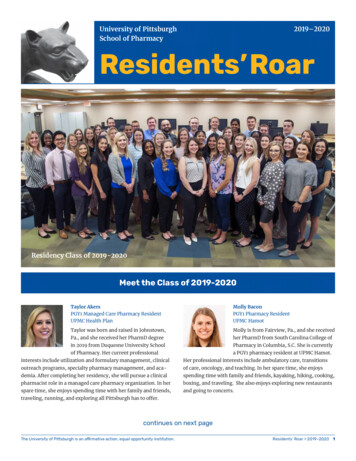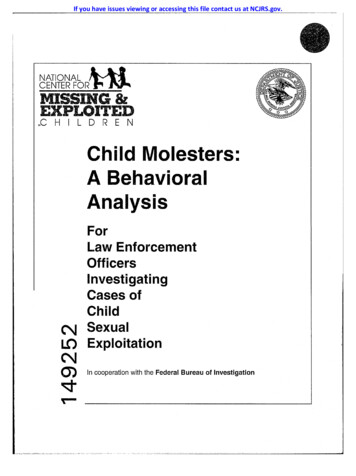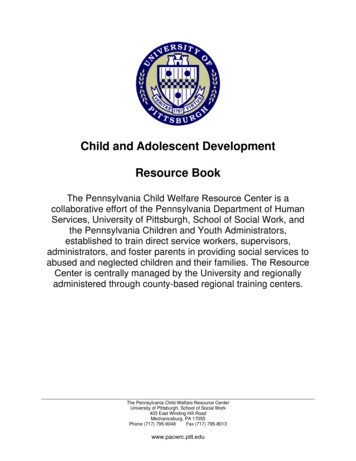
Transcription
Child and Adolescent DevelopmentResource BookThe Pennsylvania Child Welfare Resource Center is acollaborative effort of the Pennsylvania Department of HumanServices, University of Pittsburgh, School of Social Work, andthe Pennsylvania Children and Youth Administrators,established to train direct service workers, supervisors,administrators, and foster parents in providing social services toabused and neglected children and their families. The ResourceCenter is centrally managed by the University and regionallyadministered through county-based regional training centers.The Pennsylvania Child Welfare Resource CenterUniversity of Pittsburgh, School of Social Work403 East Winding Hill RoadMechanicsburg, PA 17055Phone (717) 795-9048Fax (717) 795-8013www.pacwrc.pitt.edu
Copyright 2005, The University of PittsburghThis material is copyrighted by The University of Pittsburgh. It may be used freely fortraining and other educational purposes by public child welfare agencies and other notfor-profit child welfare agencies that properly attribute all material use to The Universityof Pittsburgh. No sale, use for training for fees, or any other commercial use of thismaterial in whole or in part is permitted without the express written permission of ThePennsylvania Child Welfare Resource Center of the School of Social Work at TheUniversity of Pittsburgh. Please contact the Resource Center at (717) 795-9048 forfurther information or permissions.The Pennsylvania Child Welfare Resource Center
Child & Adolescent DevelopmentResource BookThe Pennsylvania Child Welfare Resource Center
Adapted with permission from:“Child and Adolescent Resource Book”, The Center for Child and Family Studies, College ofSocial Work, University of South Carolina“Child Development Milestones”, The Northern California Children and Family ServicesTraining Academy, University of California at DavisBrittain, C., & Hunt, D. E. (Eds.) (2003). American Humane’s Helping in child protectiveservices: A competency-based casework handbook. New York: Oxford University Pressii
Table of ContentsHow to Use This Resource Book . 1Principles & Theory . 3Principles of Development . 4Special Topics in Development . 6Foundations . 12Tables & Charts . 19Fetal Development . 20How to Use the Growth Charts . 23Growth Charts—Girls (0 through 2) . 24Growth Charts—Boys (0 through 2). 26Growth Charts—Girls (2 through 19) . 28Growth Charts—Boys (2 through 19). 29Tables of Developmental Characteristics and Markers . 30Observation Notes . 33Infancy (0 to 12 Months) . 34Toddlerhood (12 to 36 Months) . 38Early Childhood (3 to 6 Years) . 42Middle Childhood (6 to 11 Years) . 48Early Adolescence (11 to 15). 54Adolescence (15 to 19) . 58Normal Developmental Challenges and Strategies. 62Challenges Beyond Normal Development. 71Prenatal Risks. 73Failure to Thrive . 74Children with Disabilities . 76Alcohol and Drug Exposure. 79Effects of Maltreatment on Development . 80Effects of Separation and Loss on Children . 84Factors that Influence a Child’s Reaction to Parent Separation or Loss. 86Phases of Grief . 88Glossary . 93Suggested Resources . 97iii
How to Use This Resource BookThis Child and Adolescent Development Resource Book was created for use as both a trainingtool and a reference for child welfare workers. Information in the book is presented in traininglectures and activities. Using the book in training should facilitate its use in practice. Workersare encouraged to keep the book handy after training for quick reference in working with childand adolescent clients and their families.The first section of the book contains information on principles of development, and then goesinto more depth on key topics, such as attachment and brain development. It also brieflydiscusses major theorists to help the worker understand the foundations of our current knowledgeof human development. Workers will find that at least a nodding acquaintance with it will helpthem understand something about how our knowledge has evolved, and continues to do so.The second section contains charts and tables that provide general guidelines on what to expectof children and adolescents at different ages and stages of development, as well as “red flags” fordevelopmental concerns and tips for enhancing development. These are divided into six stagesof development, from birth through adolescence, plus information on fetal development. In thetraining, we treat development in three domains: physical, cognitive/linguistic, andsocioemotional. We are treating language development as part of cognitive development, but inthe tables, because of the amount of information on language development and its importance,we have given it a separate heading. Moral development, while part of the socioemotionaldomain, also has been given a separate heading for the same reason. This section also coversinformation on common issues in normal development that can cause stress for parents (e.g.,potty training) and offers tips for enhancing development and dealing with problems caused bynormal developmental tasks at various ages.The child welfare worker who can recognize normal milestones can also spot deviance from thenorm, try to ascertain its causes, and suggest the most appropriate interventions. It is important toremember, however, that variations somewhat before and after the “normal” time for an individualto complete a developmental task are also considered within the norm. Though the sequence ofdevelopment is consistent for all individuals, each individual develops in a unique way.The third section includes information to help workers understand developmental issues that gobeyond normal development, including developmental disabilities, the effects on the child of fetalalcohol and drug exposure, and common effects of maltreatment on growth and development.The Glossary defines universal terms and language that will help the worker understandinformation on child and adolescent development, talk with families and other professionalsabout it, write reports, and request appropriate services. The “Suggested Resources” sectioncontains books, articles, book chapters, and websites that may be useful to the worker who wantsfurther knowledge and understanding. Some of these sources were used in the development ofthe training for which this book was compiled.Child & Adolescent Development 1
2 The Pennsylvania Child Welfare Resource Center
Principles & TheoryChild & Adolescent Development 3
Principles of DevelopmentGrowth and development are the result of both nature and nurture. They are influenced bya combination of genetic, biological, environmental, and experiential factors. An individualchild’s progression through the developmental stages is the result of a unique mix of physicaland mental predispositions and attributes, as well as environmental conditions, such as poverty,prenatal drug exposure, or empathic parenting.Development occurs across a number of interconnected domains. Development in eachdomain is closely interwoven with development in the others, though it may not proceed evenlyacross domains in a parallel fashion (e.g., language development may at times outstrip physicaldevelopment or vice versa.) In this book, we consider three major domains: physical,cognitive/linguistic, and socioemotional. Different writers may divide domains somewhatdifferently—for instance, treating moral development or language development as separatedomains rather than a part of socioemotional or cognitive development. But, however it ispresented, the information is essentially the same.Development is progressive over time. It unfolds in a series of stages in a consistent sequence.Though each individual develops in a unique way, the sequence of development is consistent forall individuals. For example, in general, children gain control over their bodies from head to toeand from the center out (Fahlberg, 1991.) An infant will be able to focus his or her eyes andfollow an object before being able to lift his or her head.For each stage of development, there are milestones that tell whether or not the individual hasachieved typical, or “normal,” development in the three domains. More broadly, there aredevelopmental tasks that each individual needs to complete for each major developmental stagein each domain before he or she can proceed with optimum hope for success to the next stage. Iftasks at a particular stage are not adequately completed, problems are likely to appear at futurestages of development.Individuals’ development does not always proceed evenly or at the same rate. Some degreeof variation around what is considered the normal time for an individual to complete adevelopmental task should still be considered within the normal range. These normal variationswould be smaller in the case of an infant in a period of rapid growth and development, but mightbe as much as six months for an adolescent.Development proceeds most rapidly in the earliest months and years of life, especially before agefive. Deficiencies in care at that stage can have especially serious effects on physical, cognitive,and social development. For example, rapid brain and body growth before age two makesinfants highly susceptible to malnutrition, which, if not corrected, can lead to brain damage,mental retardation, and/or growth retardation.For most individuals, growth and development occur within a family or family-like context.Thus, the parent figures are the ones who are primarily responsible for seeing that the child hasneeded supports for development and is protected from conditions that would impededevelopment. To do this, caregivers need to understand the developmental process.4 The Pennsylvania Child Welfare Resource Center
Abuse, neglect, and poor parenting can severely undermine development, not just in thepsychosocial domain, but also in the moral, physical (e.g., failure to thrive,) linguistic, andcognitive domains.The effects of maltreatment on development are the result of a complex interaction of factors,including nature, duration, and severity of maltreatment; developmental stage of the child; need;physical and psychological constitution of the child; and environmental and interpersonalconditions that act to increase or mitigate risk. The prenatal and infant periods are periods ofhighest risk developmentally.For individuals who are victims of maltreatment, or who have conditions that may handicapnormal development, it is important to understand optimum developmental possibilities withineach domain at each stage and what can support or impede optimum development.Child & Adolescent Development 5
Special Topics in DevelopmentThis section includes an overview of development in several areas that have lifelong implicationsfor a child’s functioning. Areas included are attachment, language development, braindevelopment, and emotional intelligence. In-depth information on these and other areas isprovided by age level in the next section, Tables and Charts.ATTACHMENTAttachment refers to the close emotional bond children normally form with those who care forthem early on—a mother and/or father, and/or other caregivers. This happens through regular,positive contact and interaction between the infant and the caregiver(s) or other familiar figures,as when the adult feeds, comforts, plays with, and talks with the infant and the infant responds.In this way, ideally, the infant learns that he/she can communicate a need to the caregiver (e.g.,by crying) and get a response that meets the need.You can see attachment forming in the way a baby responds to the figure to whom he or she isbecoming attached; for instance, the baby touches the parent’s face.Parental behaviors that promote secure attachment are sensitive and loving handling of the infantand responses to his or her emotional states; for example, not over handling or over stimulating atired baby.The infant also plays a part, ideally, by responding to and interacting positively with thecaregiver. It is harder for some parents to respond in a consistently loving way to an infant whois often irritable and/or unresponsive.John Bowlby, a child psychiatrist, first drew attention to the clinical importance of the concept ofattachment (Bowlby, 1969.) He theorized that children have an instinct to seek or maintainproximity to their caregiver, which he called the attachment instinct. He postulated that thepattern of an infant’s early attachment to parents would form the basis for all later socialrelationships. According to Bowlby, children typically exhibit what he called secure-basebehavior, leaving the caregiver to explore their environment and returning to seek comfort whenthey are anxious. He hypothesized that when the caregiver was unavailable or only partiallyavailable during the first months of the child’s life, the attachment process would be interrupted,leaving enduring emotional scars and predisposing a child to behavioral problems. A child withseparation anxiety also would be likely to spend less time exploring his or her environment,which could interfere with future development in the physical or cognitive domains.Bowlby’s colleague, Mary Ainsworth (Ainsworth, Blehar, Waters, & Wall, 1978,) went on todescribe four patterns of attachment that may develop based on early interactions between childand caregiver. These are:6 The Pennsylvania Child Welfare Resource Center
Secure attachment – Infants separate readily from their caregivers when caregivers leave,but then happily greet them when they return. Infants use their caregivers as a securebase, leaving them to explore, but then returning to them for occasional reassurance.Avoidant attachment – Infants rarely cry when their caregivers leave, and avoid themupon their return. They do not reach for their caregivers in time of need.Ambivalent or resistant attachment – Infants become anxious even before their caregiversleave, but then show ambivalence toward them when they return (seeking them out and thenresisting contact with them.) These infants do little exploring and are hard to comfort.Disorganized-disoriented attachment – Perhaps the least secure attachment. Infantsshow inconsistent, contradictory behavior. They greet their caregivers, but then turnaway or approach them without looking at them. They seem confused and afraid.The child who is securely attached generally prefers the parent to a stranger and is comfortableleaving the parent to explore farther afield, but will then return to the parent. Children who arenot so securely attached may not appear to prefer the parent, or may indiscriminately seekattention and affection.Attachment is important because it is the first kind of relational experience the baby has and thusbecomes the foundation for other relational experiences in life.Many theorists believe attachment is necessary for the attainment of developmental tasks. Forexample, Erikson describes the primary task for the first period of life as establishing “basic trustversus basic mistrust.” The child who learns through attachment that his or her needs will be metis more able to resolve this task positively, and is ready to proceed along the normaldevelopmental path. The child who does not learn this early in life may be at a disadvantagedevelopmentally, because this child cannot trust that his/her needs will be met.Securely attached infants are more likely to become securely attached children. These childrenare more likely to show: Self-esteem;Independence and willingness to explore on their own;Social and academic competence;Trust in people;Willingness to ask for help when they need it; andSuccess in their relationships with peers and significant adults.Though early secure attachment is believed by many to be crucial to ongoing normal developmentin later stages, consistency of attachment is also important. Trust can be lost if attachment is notmaintained. Attachments may also become more secure if parents or other caregivers are able toimprove their parenting and show more positive emotion in their interactions with their children.Child & Adolescent Development 7
It is also important to recognize that, in some cultures, children have more caregivers, or areparented more by siblings or grandparents, for example, than by parents. These children mayform more attachments or may form primary attachments, not to parents, but to other people.When multiple attachments are a cultural and social norm, you would expect to see childreneasily moving between adult caregivers.L ANGUAGE D EVELOPMENTLanguage development is crucial to the development of higher-level thinking, reasoning, andmemory processes. Language gives us a way to experience and manipulate our world throughsymbols. For example, language gives children a way to express emotions without physicallyacting them out, and a way to relate to and learn from others’ thoughts and feelings (Fahlberg,1991.)Children learn language in the social context—by hearing others use words and word combinationsand connecting these with things, happenings, and other kinds of meaning. Words are symbols.Attentive parents or other caregivers help babies learn to talk in several ways: by talking withthem, especially slowly and distinctly, and as if they could understand whatever is being said; bytalking about what children are looking at or doing; and by playing games with them that involvewords and taking turns, as in conversation (for example, pat-a-cake.)Exposure to speech helps children learn to speak. More specifically, ways to help children learnto speak are labeling (identifying the names of objects,) echoing (repeating what the child says,)and expanding or recasting (restating what the child has said, but in a more sophisticated form.)Babies with normal hearing prepare for language development by beginning to coo around2 months and to babble around 6 months. They add consonants and syllables to the coos from6 to 14 months and, on average, by 7 months are making some sounds of mature spokenlanguage.From 6 to 9 months, children begin to understand words, or have a receptive vocabulary. Theysay their first words around 12 months, on average. These are usually words that nameimportant people (mama, dada,) objects (car,) or animals (doggie,) or words that conveygreetings or leave-takings (hi, bye-bye.)Once the child speaks his/her first word, the spoken vocabulary grows rapidly. Between 18 and24 months, it may grow from about 50 words to as many as 300 words.At 20 to 26 months, children start making two-word combinations that mean something(telegraphic speech.) By the end of the second year, most children are making simplesentences. From 2 to 3 years into the school years, they are learning to make complex sentences.Parents can help by encouraging younger children to make whole sentences.8 The Pennsylvania Child Welfare Resource Center
Children have to learn many things in learning language: word meanings and shades ofmeanings; pronunciations; word combinations and arrangements; sentence structure; nonverbalaccompaniments to spoken language; tone of voice; acceptable volume in various situations; andadapting speech to make meaning clear to a variety of people.Among the impediments to learning language are isolation, lack of response to attempts to speak,and disabilities, such as deafness.Culture plays a big part in how children learn languages. For example, in a large, extendedfamily that interacts regularly, a child is likely to be exposed to more talk and may learn morewords faster than a child who interacts with only one parent. Also, when the language spoken athome is different from the language of the culture in which a family lives, children in the familymay have a harder time learning the culture’s language.Gender also plays a role in language development, particularly at young ages. Research hasshown (Feingold 1992, 1993) that although both boys and girls appear to comprehend languageequally well, girls tend to produce language at earlier ages. As infants, girls produce moresounds at an earlier age, use words sooner, and have larger vocabularies than boys. Usage ofstandard grammar also proceeds more rapidly for toddler girls. This advantage in languageproduction for girls gradually diminishes until, by late adolescence, boys catch up.Depending on age, children may not: Remember what day of the week something happened (“Did Mommy leaveon Monday or was it Tuesday?”)Understand sequence expressed as before and after (“Did Tommy hit youbefore he took the cookie?”)Understand the difference between the and a, and understand more/less andsome/all comparisons.Understand do you remember questions.Be able to decipher embedded ideas (“Did the boy who hit you take yourcookie?”)Understand the passive voice (“Were you hit by Janie?”)B RAIN D EVELOPMENTBrain development begins in the third to fourth week after conception. By the end of the secondtrimester, the child has more than 100 billion neurons, or nerve cells—all that he or she will everhave. After birth, these neurons form connections, or synapses, in response to outsidestimulation. Learning occurs through these connections. Much of the brain’s growth anddevelopment occurs during the first few years after birth. By age 3, a baby’s brain isapproximately 90% of its adult size. Thus, early stimulation and interaction with the world arecritical to determining the person we become.Child & Adolescent Development 9
Earlier thinking about children and how they learn viewed them as unreasoning beings who simplytook in what was going on around them in infancy without being able to make sense of it untilsometime later. More recent research on brain development has shown that this is not the case. Infact, children are reasoning beings even in the early months of life. They take in and assimilateinformation and experience, acquiring knowledge about the world and skills to function in it.From more recent brain research we know that: There are “windows of opportunity” for acquiring specific kinds of skills and information,times when a part of the brain can pick up and use this new material more easily than othertimes. (For example, children are best able to acquire music and math skills from 1 to 5years of age.)Acquiring skills or information at these prime times helps future development occur inthe best possible time and way.Learning (acquiring information and skills and knowing how to use them) occurs througha combination of things, including genetics, interaction with and response from others,and other environmental stimulation.Interactions with others and the environment help the child keep certain brain cell connectionsand discard others. Connections that are used over and over form the basis of the child’s brainorganization and function. This is why stimulation and outside opportunities for experience areimportant.However, some experts believe that our new knowledge about critical learning periods has led toexcessive concern, resulting, in some cases, in pushing young children too hard into learningsituations (e.g., David Elkind, “The Hurried Child.”) Over stimulation can be harmful, just asunder stimulation can, perhaps leading to burnout and emotional stress at a young age.The brain continues to develop throughout life to adapt to experience. This makes it possible forindividuals to continue learning and, in some cases, to reverse the damage from periods ofsensory deprivation. From what we know now, though, it is far better for a child to get optimalcare and stimulation for brain development early in life.What children need in the first three years to achieve their highestpotential: Good maternal health during the prenatal period;A feeling of safety;Belief that their needs will be met;A feeling of importance to others;A balance of freedom and limits; andExposure to appropriate and diverse experiences involving, for example, toys,music, books, playmates, parents, and other adults.10 The Pennsylvania Child Welfare Resource Center
E MOTIONAL I NTELLIGENCERecently, there has been significant work on the concept of emotional intelligence. DanielGoleman, a chief reporter of and spokesperson for this work, describes it generally by saying thatIQ alone is not the most important thing for success. Rather, emotional intelligence, orunderstanding and managing one’s feelings wisely, is more important. Some examples are: Being able to identify and talk about one’s feelings, such as anxiety and anger, and to seehow these direct thoughts and behaviors;Being able to control or redirect feelings to avoid fights or other dysfunctional behaviors;Knowing how to get along with other people despite differences;Being able to control one’s negative impulses and to delay gratification for a better futureoutcome;Being assertive rather than passive;Negotiating rather than fighting;Taking responsibility for one’s actions;Following through on commitments; andHaving an objective view of one’s positive and negative traits, and liking oneself despiterecognized imperfections.Thanks largely to Goleman’s work, emotional intelligence is being taught in some schools tohelp children develop and use emotional competence in dealing positively with personalproblems and with differences between themselves and others.Child & Adolescent Development 11
FoundationsIn this curriculum, we highlight a few theorists whose work has been important in child andadolescent development. They are important because they laid the foundations for currentdevelopmental theory and knowledge and, frequently, what they researched and wrote still haspractical value and is widely used today. A general familiarity with the names and ideas of thesethinkers should be a part of your understanding of developmental issues for children andadolescents.The first theorist treated here is Abraham Maslow. His hierarchy of needs still forms a goodframework for developmental issues throughout the life span. Following Maslow there is someinformation on Sigmund Freud and his work on psychosexual development. Next is ErikErikson, whose more comprehensive psychosocial theory divides the entire life span into stages,each with a specific developmental challenge and task. Also included are Jean Piaget, whose workon cognitive-developmental theory describes a universal pattern of learning to think logically,and Lawrence Kohlberg, who built on Piaget’s theory to outline stages of moral reasoning.To a large extent, these early theorists made their observations on middle- to upper-classindividuals who were more or less alike culturally. In some cases, they conducted their studiessolely on males and formed their ideas from a male perspective. Later thinkers challenged andexpanded much of their work beyond its na
The Pennsylvania Child Welfare Resource Center University of Pittsburgh, School of Social Work 403 East Winding Hill Road Mechanicsburg, PA 17055 Phone (717) 795-9048 Fax (717) 795-8013 www.pacwrc.pitt.edu Child and Adolescent Development Resource Book The Pennsyl
